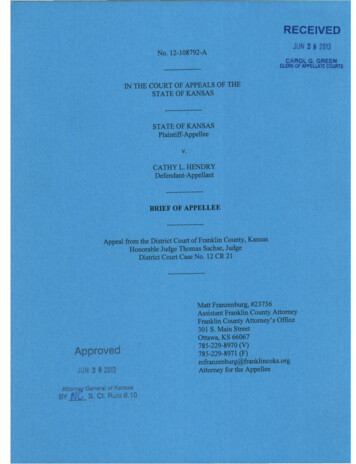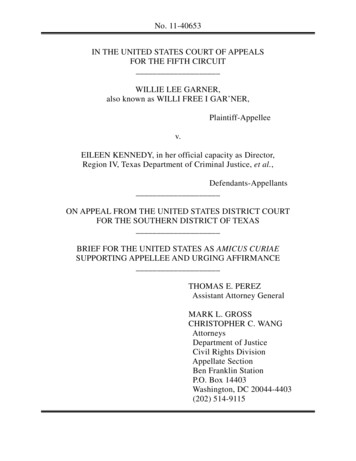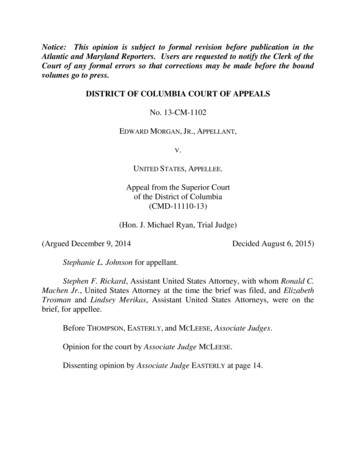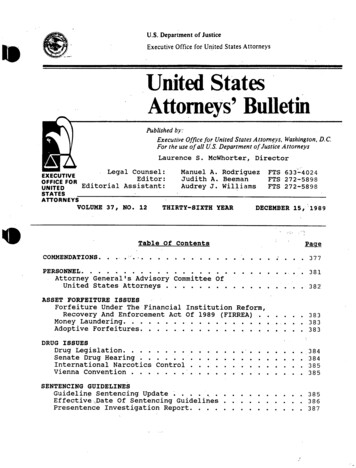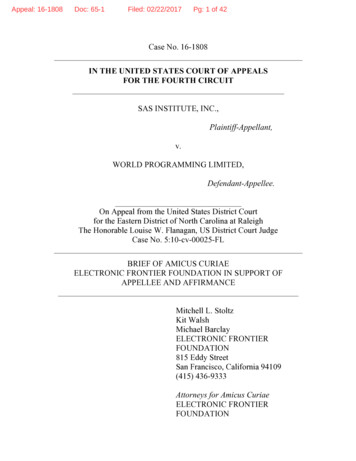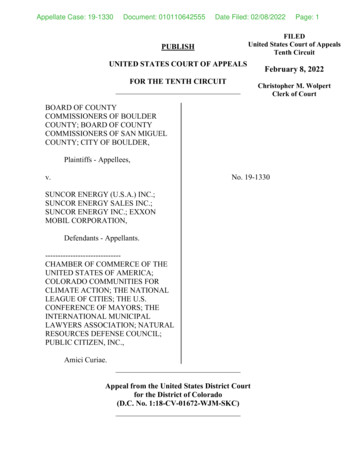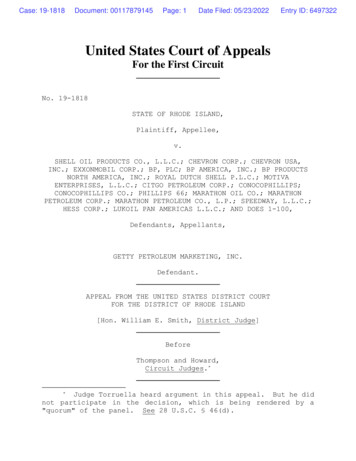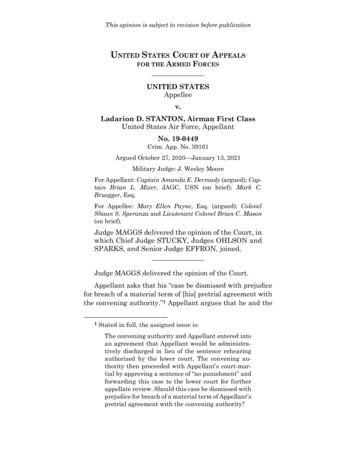
Transcription
This opinion is subject to revision before publicationUNITED STATES COURT OF APPEALSFOR THEARMED FORCESUNITED STATESAppelleev.Ladarion D. STANTON, Airman First ClassUnited States Air Force, AppellantNo. 19-0449Crim. App. No. 39161Argued October 27, 2020—January 13, 2021Military Judge: J. Wesley MooreFor Appellant: Captain Amanda E. Dermady (argued); Captain Brian L. Mizer, JAGC, USN (on brief); Mark C.Bruegger, Esq.For Appellee: Mary Ellen Payne, Esq. (argued); ColonelShaun S. Speranza and Lieutenant Colonel Brian C. Mason(on brief).Judge MAGGS delivered the opinion of the Court, inwhich Chief Judge STUCKY, Judges OHLSON andSPARKS, and Senior Judge EFFRON, joined.Judge MAGGS delivered the opinion of the Court.Appellant asks that his “case be dismissed with prejudicefor breach of a material term of [his] pretrial agreement withthe convening authority.”1 Appellant argues that he and the1Stated in full, the assigned issue is:The convening authority and Appellant entered intoan agreement that Appellant would be administratively discharged in lieu of the sentence rehearingauthorized by the lower court. The convening authority then proceeded with Appellant’s court-martial by approving a sentence of “no punishment” andforwarding this case to the lower court for furtherappellate review. Should this case be dismissed withprejudice for breach of a material term of Appellant’spretrial agreement with the convening authority?
United States v. Stanton, No. 19-0449/AFOpinion of the Courtconvening authority formed the alleged pretrial agreementwhen he requested an administrative discharge in lieu of trialby court-martial and the convening authority approved thisrequest. Appellant asserts that a material term of this allegedpretrial agreement was that the convening authority wouldvacate an affirmed finding that Appellant was guilty of an offense for which Appellant was facing a rehearing on sentencing. Appellant contends that the convening authoritybreached this material term when he approved a sentence ofno punishment instead of vacating the finding of guilt anddismissing the charge and specification with prejudice.For reasons that we explain below, we conclude that theconvening authority’s approval of Appellant’s request for adischarge in lieu of trial by court-martial was not a “pretrialagreement” within the meaning of the Rules for CourtsMartial (R.C.M.). We further conclude that, although theconvening authority made some other kind of agreement withAppellant, the convening authority did not expressly orimplicitly promise to vacate the finding of guilt and dismissthe charge and specification. We therefore answer theassigned issue in the negative and affirm the finding and thesentence in this case.I. BackgroundA general court-martial found Appellant guilty of twospecifications of sexual assault, one specification of aggravated sexual contact, and one specification of larceny of nonmilitary property of a value of 500 or less, in violation of Articles 120 and 121, Uniform Code of Military Justice (UCMJ),10 U.S.C. §§ 920, 921 (2012). The court-martial sentenced Appellant to a dishonorable discharge, confinement for ninetysix months, forfeiture of all pay and allowances, reduction toE-1, and a reprimand. The convening authority approved thesentence as adjudged.In Appellant’s first appeal, the United States Air ForceCourt of Criminal Appeals (AFCCA) affirmed the finding withrespect to the larceny specification, but set aside the findingsUnited States v. Stanton, 80 M.J. 55 (C.A.A.F. 2020) (order grantingreview).2
United States v. Stanton, No. 19-0449/AFOpinion of the Courton the sexual assault and aggravated sexual contact specifications. United States v. Stanton, No. ACM 39161, 2018 CCALEXIS 70, at *32, 2018 WL 1176463, at *10 (A.F. Ct. Crim.App. Feb. 7, 2018) (unpublished). The AFCCA also set asidethe sentence. Id., 2018 WL 1176463, at *10. The AFCCA remanded the case for further proceedings and authorized a rehearing as to the findings that it had set aside and as to thesentence. Id., 2018 WL 1176463, at *10.On remand, the convening authority initially ordered a rehearing on findings on the set aside charge and specificationsand on the sentence. The convening authority, however, laterwithdrew and dismissed without prejudice the set asidecharge and specifications. Before the rehearing on the sentence occurred, Appellant requested an administrative discharge in lieu of trial by court-martial. See Dep’t of the AirForce, Instr. 36-3208, Administrative Separation of Airmenpara. 4.1.1. (July 9, 2004) [hereinafter AFI 36-3208] (“Airmenmay be discharged under this provision if they . . . [a]re subject to trial by court-martial; and . . . [r]equest discharge inlieu of trial.”). Appellant made this request in a one-pagememorandum that he submitted to the convening authority.The first paragraph stated: “I request that I be dischargedfrom the United States Air Force according to AFI 36-3208,Chapter 4, in lieu of trial by court-martial.” In the remainingparagraphs, Appellant acknowledged that he understood theoffense with which he was charged, that he might be discharged under other than honorable conditions, and that if hewere tried by a summary court-martial, he could not receivea punitive discharge. He also acknowledged that he had beenafforded the right to consult legal counsel and had received aPrivacy Act statement. Appellant and his defense counselsigned this document.The convening authority approved the request in a memorandum stating simply: “The request for discharge in lieu oftrial by court-martial submitted by A1C Ladarion D. Stanton,under AFI 36-3208, Chapter 4, is approved. I direct A1C Stanton be discharged with an Under Other Than Honorable Conditions service characterization.” The convening authority3
United States v. Stanton, No. 19-0449/AFOpinion of the Courtsigned this memorandum, and Appellant was administratively discharged.2 Two days later, the convening authoritysigned an order in which he found that a sentencing rehearingon the larceny offense was impracticable and in which he approved a sentence of “no punishment.”In his second appeal to the AFCCA, Appellant argued thatthe convening authority’s approval of his administrative discharge had the effect of dismissing the larceny specification.See United States v. Stanton, No. ACM 39161 (reh), 2019 CCALEXIS 306, at *5, 2019 WL 3409927, at *2 (A.F. Ct. Crim.App. July 16, 2019). The AFCCA, however, rejected this argument, concluding that an administrative discharge doesnot terminate appellate jurisdiction over a court-martial andthat the convening authority did not dismiss the larceny specification. Id. at *5–7, 2019 WL 3409927, at *2–3. The AFCCAalso rejected Appellant’s argument that he and the conveningauthority had formed an agreement in which Appellant hadagreed to accept an administrative discharge in exchange forthe convening authority’s setting aside the finding that hewas guilty of larceny and dismissing the charge. Id. at *8–10,2019 WL 3409927, at *4. The AFCCA reasoned that the convening authority had no power to set aside the finding of guiltbecause it had already been affirmed on appeal. Id. at *9–10,2019 WL 3409927, at *4. The AFCCA also reasoned that Appellant did not present evidence proving that the conveningauthority had agreed to set aside or dismiss the larceny conviction as a condition of Appellant’s administrative discharge.Id. at *10, 2019 WL 3409927, at *4. Accordingly, the AFCCAdeclined to set aside the finding on the larceny charge andspecification, and affirmed the sentence of no punishment. Id.at *2–3, 2019 WL 3409927, at *1.2The parties do not explain in their briefs how Appellant’smemorandum requesting a discharge or the convening authority’smemorandum approving the request are part of the “record” as defined in R.C.M. 1103(b)(2) or are “[m]atters attached to the record”as defined in R.C.M. 1103(b)(3). See United States v. Jessie, 79 M.J.437, 440–41 (C.A.A.F. 2020) (discussing what courts may review onappeal). We consider these documents in this case without rulingon this issue because neither party has objected to our consideration of them.4
United States v. Stanton, No. 19-0449/AFOpinion of the CourtWe granted Appellant’s petition for review of the AFCCA’sdecision. Before addressing Appellant’s arguments to thisCourt, we note that Appellant also contested the finding andsentence from his court-martial in another forum. While hiscase was pending before the AFCCA, Appellant sued the convening authority and others in the United States DistrictCourt for the District of Columbia, claiming that his larcenyconviction did not survive his administrative discharge.3 SeeStanton, 2020 U.S. Dist. LEXIS 59040, at *1, 2020 WL1668039, at *1. The district court rejected Appellant’s argument with reasoning nearly identical to that of the AFCCA.The district court determined that the convening authorityhad no power to set aside the finding that he was guilty of thelarceny specification because the AFCCA had already affirmed it. Id. at *16, 2020 WL 1668039, at *6. In addition, thedistrict court rejected Appellant’s contention that he did notreceive the “benefit of his bargain” in requesting a dischargein lieu of trial by court-martial. Id. at *19, 2020 WL 1668039,at *7. The district court reasoned that this case differed froma typical case in which an accused requests a discharge in lieuof trial by court-martial. Id., 2020 WL 1668039, at *7. Thedistrict court explained that in a typical case, the accusedmakes the request for a discharge before trial but here theaccused made the request after the trial had already occurredand the finding of guilt had already been affirmed. Id., 2020WL 1668039, at *7. The district court concluded that in thecircumstances of this case, Appellant did receive the benefitof his bargain, stating: “Here, Stanton’s sentence was abated,which was the appropriate outcome for a discharge in lieu ofa re-sentencing hearing.” Id. at *21, 2020 WL 1668039, at *7.3Appellant initially styled this lawsuit as a petition for a writof habeas corpus. See Stanton v. Jacobson, Civil Case No. 19-699(RJL), 2020 U.S. Dist. LEXIS 59040, at *1 n.1, 2020 WL 1668039,at *1 n.1 (D.D.C. Apr. 3, 2020). The district court held that it didnot have jurisdiction to grant a writ of habeas corpus because 28U.S.C. § 2241(c) precludes granting habeas relief unless a petitioneris in custody. Id., 2020 WL 1668039, at *1 n.1. The district court,however, determined that it could entertain a collateral attack inthe exercise of its federal question jurisdiction under 28 U.S.C.§ 1331. Id., 2020 WL 1668039, at *1 n.1.5
United States v. Stanton, No. 19-0449/AFOpinion of the CourtII. DiscussionA. JurisdictionThis Court has jurisdiction to address the assigned issue,which, to repeat, is whether “this case [should] be dismissedwith prejudice for breach of a material term of Appellant’spretrial agreement with the convening authority.” We agreewith the AFCCA’s decision that Appellant’s discharge duringthe pendency of the court-martial proceedings did not removehim from the jurisdiction of the court-martial, the AFCCA, orthis Court. See United States v. Davis, 63 M.J. 171, 177(C.A.A.F. 2006) (holding that an administrative dischargewhile a rehearing is pending does not terminate jurisdictionover the person of the accused). We recognize that this Courtdoes not have jurisdiction to disturb administrative discharges. See Clinton v. Goldsmith, 526 U.S. 529, 535–36(1999) (holding that this Court did not have jurisdiction to enjoin the administrative separation of a servicemember). ButAppellant has not asked us to take any action with respect tohis administrative discharge. Instead, Appellant requestsonly that we set aside the finding of guilt on a larceny specification and the sentence of no punishment that the AFCCAaffirmed in this case. Article 67(c), UCMJ, 10 U.S.C. § 867(c)(2018), expressly grants this Court jurisdiction to act on suchrequests. And in exercising such jurisdiction, we have previously considered precisely the kind of argument that Appellant now makes, namely, that a convening authority breacheda term of a pretrial agreement. See United States v. Lundy,60 M.J. 52, 60 (C.A.A.F. 2004) (holding that remedial actionis required when the government does not fulfill a materialprovision in a pretrial agreement).B. Pretrial AgreementAppellant contends that he formed a “pretrial agreement”with the convening authority when he submitted his requestfor a discharge in lieu of trial by court-martial and the convening authority approved this request. Focusing on thewords “in lieu of” in the phrase “in lieu of trial by court-martial,” Appellant contends that the “plain reading” of thisagreement was that he would be administratively dischargedand in exchange there would be no sentencing rehearing, thefinding on the larceny specification would be set aside, the6
United States v. Stanton, No. 19-0449/AFOpinion of the Courtlarceny specification would be dismissed, and he would nolonger have a criminal conviction. According to Appellant,this bargain was beneficial to the Government because acourt-martial was unlikely to adjudge a punitive discharge ata rehearing on the sentence.We do not dispute that Appellant’s request for an administrative discharge, and the convening authority’s approval ofit, might be characterized as an agreement of some type. Indeed, both the AFCCA and the district court appear to haveaccepted Appellant’s contention that he and the conveningauthority had formed a “bargain” in this case. Stanton, 2019CCA LEXIS 306, at *9–10, 2019 WL 3409927, at *3; Stanton,2020 U.S. Dist. LEXIS 59040, at *18–19, 2020 WL 1668039,at *6–7. In addition, in United States v. Woods, 26 M.J. 372,374 (1988), we previously described an officer’s request fordismissal in lieu of trial by court-martial and the approval ofthat request as an “agreement.”We disagree, however, with Appellant’s argument that heand the convening authority formed a “pretrial agreement”within the meaning of the R.C.M. The argument is incorrectbecause R.C.M. 705 imposes specific parameters on pretrialagreements, and Appellant’s request for a discharge in lieu oftrial by court-martial and the convening authority’s approvalof that request do not fit within these parameters. In ourview, Appellant is attempting to fit a square peg into a roundhole.To form a pretrial agreement, the accused must submit awritten offer to the convening authority. R.C.M. 705(d)(2).This written offer must propose a bilateral agreement inwhich the defense and the government each make promisesto the other. On one side, the proposed agreement may include “[a] promise by the accused to plead guilty to, or to entera confessional stipulation as to one or more charges and specifications, and to fulfill such additional terms or conditionswhich may be included in the agreement and which are notprohibited under this rule.” R.C.M. 705(b)(1). On the otherside, the proposed agreement may include:[a] promise by the convening authority to do one ormore of the following:7
United States v. Stanton, No. 19-0449/AFOpinion of the Court(A) Refer the charges to a certain type of courtmartial;(B) Refer a capital offense as noncapital;(C) Withdraw one or more charges or specifications from the court-martial;(D) Have the trial counsel present no evidence asto one or more specifications or portions thereof; and(E) Take specified action on the sentence adjudged by the court-martial.R.C.M. 705(b)(2).Appellant’s memorandum to the convening authority isnot such an offer. As described above, the memorandum requests an administrative discharge and makes various acknowledgments about the circumstances surrounding the request. The request does not propose an agreement in whichAppellant will promise to plead guilty, make a confession, orfulfill any other term, and in which the convening authoritywill make any of the authorized kinds of promises.In addition, in a pretrial agreement, “[a]ll terms, conditions, and promises between the parties shall be written.”R.C.M. 705(d)(2). While we recognize that a written agreement may contain some implied terms, and may incorporateother terms by reference, what Appellant is arguing simplygoes too far. We see nothing in Appellant’s written request fora discharge, the convening authority’s written approval of therequest, or in AFI 36-3208 that indicates that the conveningauthority would vacate or set aside Appellant’s affirmed larceny conviction. Appellant nonetheless contends that the“reasonable understanding of both A1C Stanton and the Government was that A1C Stanton’s administrative discharge. . . was in place of continuing with his court-martial.” But inour view, to find such a term not in the text of these documents, but instead based on inferences about what the partiesunderstood the words “in lieu of” to mean, would contradict8
United States v. Stanton, No. 19-0449/AFOpinion of the Courtthe writing requirement of R.C.M. 705(d)(2). For these reasons, we conclude that Appellant and the convening authoritydid not form a pretrial agreement under R.C.M. 705.4C. Another Type of Enforceable AgreementAlthough Appellant and the convening authority did notform a “pretrial agreement” within the meaning of R.C.M.705, the question arises whether they may have formed someother type of agreement that this Court might enforce. InWoods, an officer submitted a request to resign in lieu of trialby court-martial shortly after referral of the charges to a general court-martial. 26 M.J. at 373. While the Secretary of theArmy was reviewing the request, the court-martial tried theofficer, found him guilty, and sentenced him to dismissal andconfinement for seven months. Id. After the convening authority approved the finding and sentence, but before his appeal was resolved, the Secretary of the Army approved theofficer’s request and administratively discharged the officer.Id. The officer contended that the administrative dischargeabated the case, and this Court agreed. Id. at 375. We heldthat “a court-martial can neither deprive the Secretary of hispowers nor defeat a lawful agreement between an accusedand the Secretary.” Id. We therefore concluded that the courtmartial could not dismiss the officer. Id. Under Woods, therefore, an approved request for an administrative discharge isan agreement that this Court can enforce.The Government questions whether Woods is still valid after the Supreme Court’s decision in Goldsmith, 526 U.S. 529,which the Government argues “reinforced this Court’s verylimited ability to address administrative matters.” In thiscase, however, we need not decide whether Goldsmith limitedour decision in Woods. Even if we presume that Woods is still4Because we conclude that Appellant and the conveningauthority did not form a pretrial agreement, we need not consideradditional questions such as whether the alleged agreementcontains prohibited terms. See R.C.M. 705(c)(1)(B) (prohibitingterms that deprive the accused, among other things, of the right tocomplete sentencing proceedings); United States v. Montesinos, 28M.J. 38, 45 (C.M.A. 1989) (stating that a convening authority lackedpower on remand to set aside a finding of guilt because theremanding court had not authorized the convening authority to setaside the finding).9
United States v. Stanton, No. 19-0449/AFOpinion of the Courtvalid precedent, we still do not believe that the convening authority did anything improper.When Appellant requested a discharge “in lieu of trial bycourt-martial” and the convening authority approved that request, we believe that the “trial” to be avoided was the resentencing hearing, not the entire court-martial. A resentencinghearing is a “trial” in the sense that it is a “formal judicialexamination of evidence and determination of legal claims inan adversary proceeding.” Black’s Law Dictionary 1812 (11thed. 2019) (entry for “trial”). The convening authority logicallycould approve an administrative discharge “in lieu of” a resentencing hearing because the resentencing hearing had notyet occurred. And that is apparently what the convening authority intended, as evidenced by the civilian defense counsel’s admission that he knew the convening authority was notgoing to disturb the findings. In contrast, we have difficultyseeing how the convening authority could approve an administrative discharge in lieu of the trial on the merits of the larceny specification because that part of the court-martial hadalready occurred, the court-martial had found Appellantguilty, the convening authority had approved the finding, andthe AFCCA had affirmed the finding. Looking at the entirecircumstances, we agree with the district court’s view thatAppellant received what he requested: “Stanton’s sentencewas abated, which was the appropriate outcome for a discharge in lieu of a re-sentencing hearing.”5 Stanton, 2020 U.S.Dist. LEXIS 59040, at *21, 2020 WL 1668039, at *7.D. Additional DiscussionIn this case, we decide that the convening authority didnot violate a material term of a pretrial agreement or anyother agreement. In reaching this conclusion, we take no position in this opinion on whether convening authorities shouldor should not approve discharges in lieu of trial by court-martial when a case is remanded for resentencing. We are concerned, however, that such requests and approvals might5The parties have not addressed whether this Court must follow the district court’s decision as a matter of issue preclusion.Given that we agree with the district court, we see no need to raisethe question of issue preclusion sua sponte.10
United States v. Stanton, No. 19-0449/AFOpinion of the Courtagain arrive at an appellate court, as it did in this case, without review first by a military judge and without any clear indication of how the administrative discharge paperwork became part of the record. Absent further guidance on thesesubjects by amendments to the UCMJ, the R.C.M., or applicable service regulations, the counsel on both sides may faceuncertainty regarding any such arrangements.6III. ConclusionThe decision of the United States Air Force Court of Criminal Appeals is affirmed.6Future cases, for example, might raise issues regarding thevoluntariness of arrangements that effectively waive sentencingproceedings and the role of the military judge in assessing the voluntariness and the content of such arrangements. We do not address those issues in this case because the parties have not raisedthem.11
Oct 27, 2020
